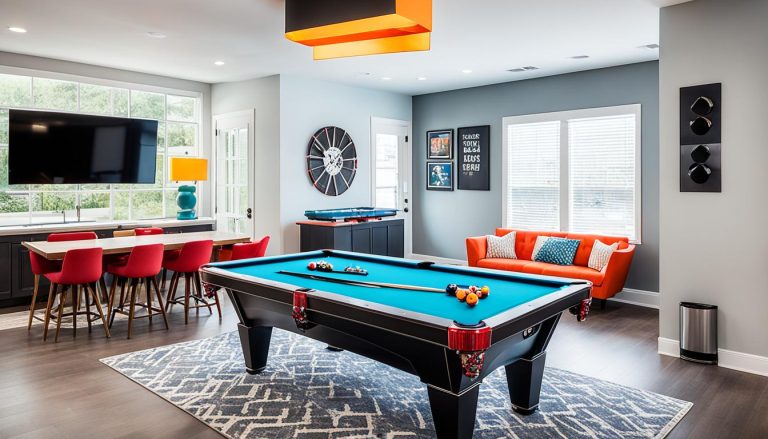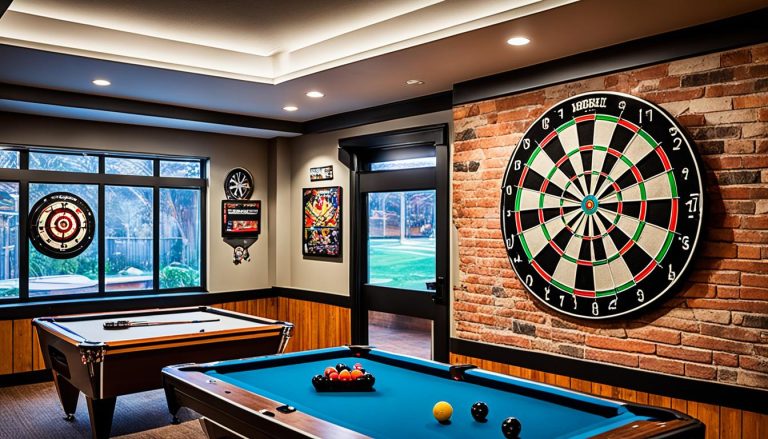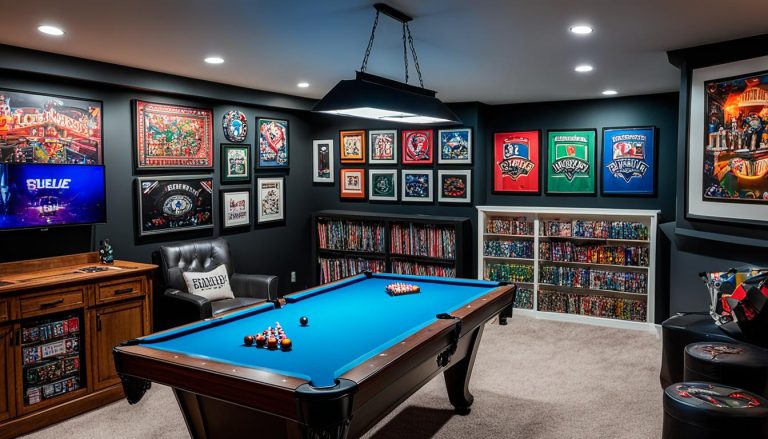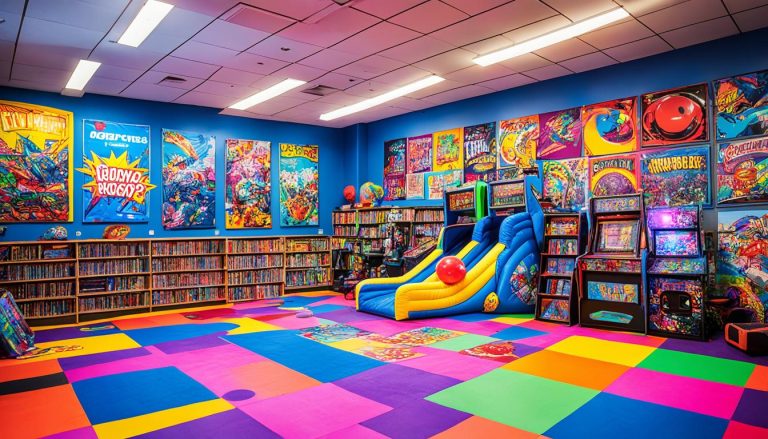Games Room Ideas for Kids: Playtime Central
houseremodelingnews.com may earn a commission if you purchase a product through one of our links
“Play is the highest form of research,” said Albert Einstein. What better way to encourage this than with a dedicated games room for your kids? Turning a space into a kids’ play area is more than just fun. It’s about boosting creativity, learning, and growth.
Designing the perfect indoor play spaces for your kids might seem tough. But with the right ideas, you can make a magical place where dreams come alive. You can use loft areas, large closets, or basement corners to create something special.
When thinking of games room ideas for kids, aim for a mix of fun and practicality. Edmund Barr’s “26 Kids’ Storage Ideas to Control Clutter” shows smart ways to keep toys tidy while keeping things fun. A great play area is not just about looks. It’s about giving your kids a place to learn, explore, and grow.
Are you ready to start making a playtime central for your kids? Let’s explore vibrant colors, smart storage, and fun play zones. These will turn your games room into the heart of childhood adventures.
Creating the Ultimate Kids’ Play Zone
Designing a kids playroom is a fun project that can change your home into a place where family fun happens. A well-thought-out indoor play area for kids has many benefits. It helps kids use their imagination and be more creative.
Benefits of a Dedicated Play Space
A special play area gives kids a place for creative play without making a mess everywhere. It helps them be more independent and lets them follow their interests. Research shows that 80% of playrooms have climbing or active play parts. This encourages kids to be more active and grow.
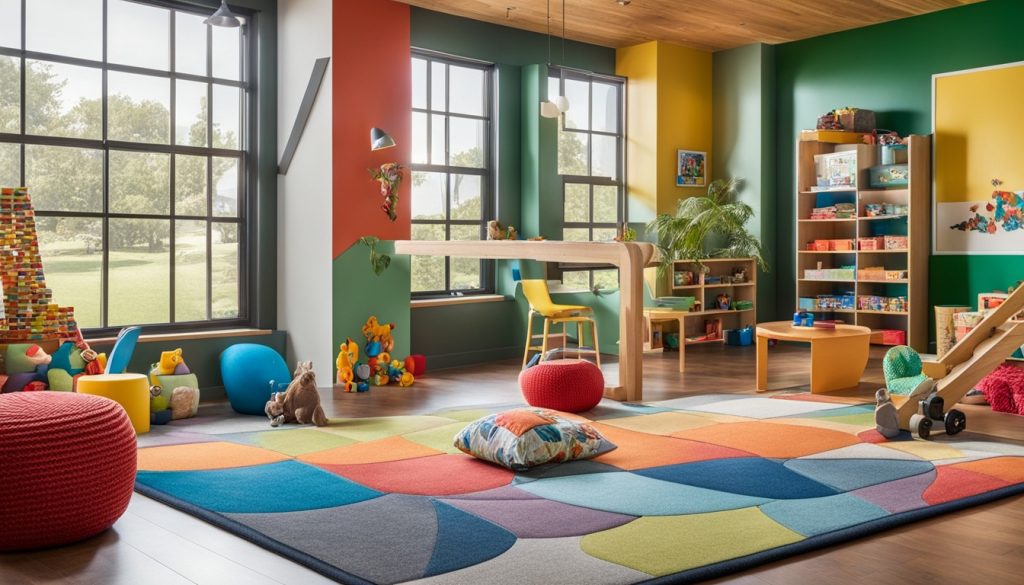
Choosing the Right Location
When picking a spot for your kids’ play area, think about using spaces that aren’t being used much. Lofts, big closets, or basement corners can become cozy play spots. Make sure the spot is easy for kids to get to and safe for them.
Balancing Fun and Functionality
Make a space that works for different activities. Add storage, kid-sized furniture, and fun decor. Here are some ideas:
- Install chalkboard walls for artistic fun
- Add comfy seating like big bean bags
- Create a quiet reading nook
- Use pegboard shelving for easy storage
- Put in a mini home gym with climbing walls
About 50% of playrooms now have areas for studying, making them useful for more things. By mixing fun and practicality, you’ll make a kids playroom that changes as your kids do. It will help them grow and learn.
Design Elements for a Kid-Friendly Games Room
Creating a fun games room for kids means thinking about playroom decor. It should be stylish yet practical to keep things tidy and fun. Here are some ideas for making your space a play paradise for children.
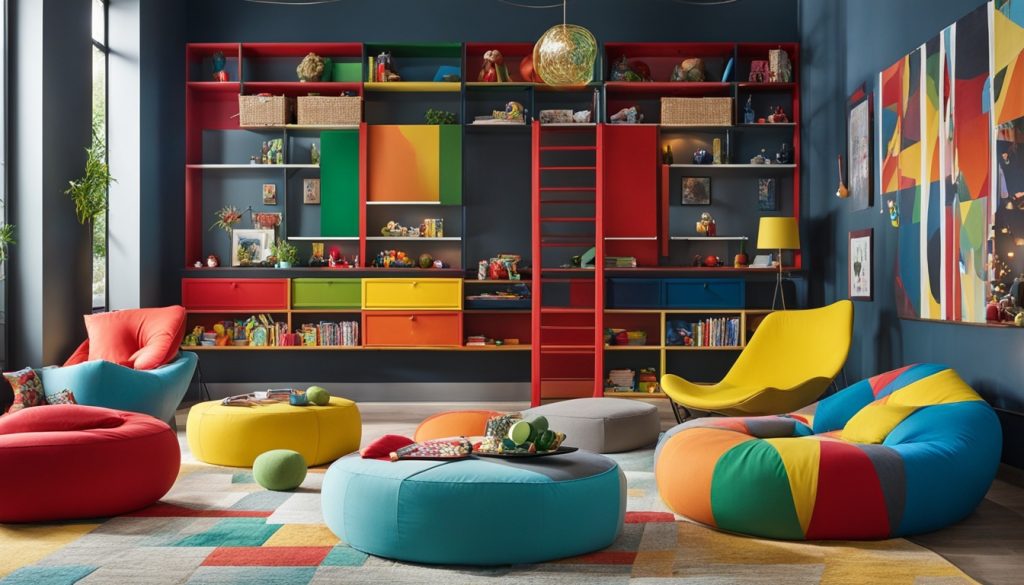
Begin with bright colors and patterns. Paint one wall with chalkboard paint for endless coloring fun. This spot lets kids be creative and have their own space. Add colorful rugs to mark play areas and make them soft for playing.
Add fun touches like rope art or handmade tassels for extra texture and look. Create a cozy reading nook with a window seat, soft cushions, and wall lights. It’s ideal for quiet time or telling stories.
- Use built-in cabinets for storing out-of-season toys and games
- Create a themed area with wall decals or murals
- Add a climbing wall to help kids expend energy
- Install adjustable shelving to adapt to changing needs
Lighting is key! Mix different lights for a warm, welcoming feel. Use task lights for crafts and soft lights for relaxing. With these ideas, your games room will be a favorite spot for kids.
“A well-designed playroom stimulates imagination and encourages learning through play.”
Storage Solutions for Toys and Games
Keeping your kids’ play area tidy can be tough. Smart toy storage solutions are essential for playroom organization. Let’s look at some game room storage solutions to help you get your space back.
Built-in Shelving and Cabinets
Built-in shelving units with base cabinets are ideal for both open and closed storage. Put favorite toys on open shelves and store art supplies and big items in drawers. This way, you keep clutter away and cleaning up easy.
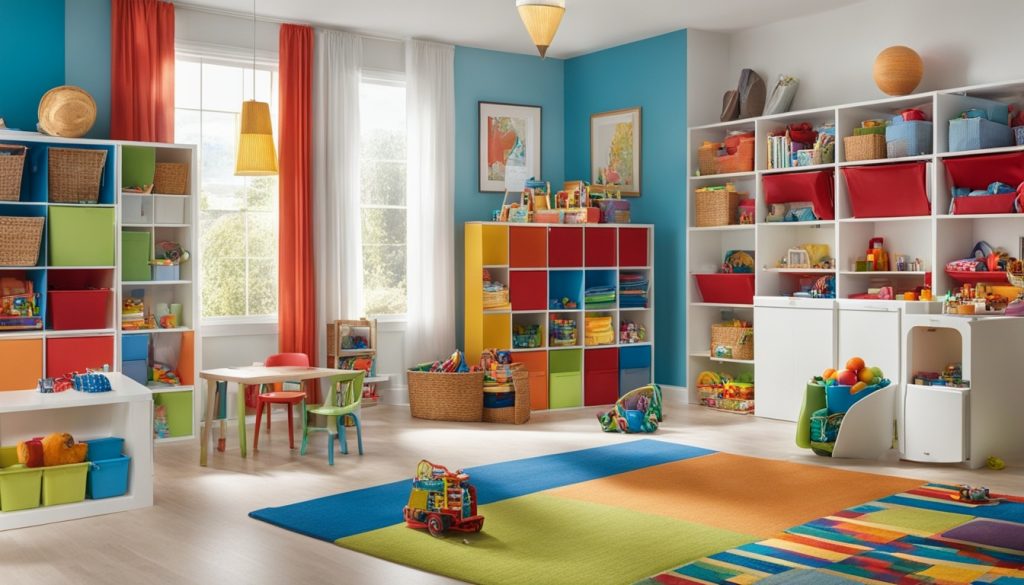
Organizing with Baskets and Bins
Baskets and bins are great for keeping playrooms tidy. Use clear containers for small toys like Legos or art supplies. Label each bin to help kids tidy up faster. Fabric bins are perfect for stuffed animals and add color to your space.
Creative Storage Ideas for Small Spaces
In small areas, think up high! Wall-mounted shelves use floor space well. Over-the-door organizers turn unused areas into storage spots. For a two-in-one solution, try storage ottomans – they offer seating and hide toys.
- Use under-bed drawers for specialty items
- Repurpose an old armoire for toy storage
- Install a built-in desk with extra storage
The best game room storage solutions fit your family’s needs. Mix these ideas to create a system that keeps your play space fun and organized.
Incorporating Educational Elements
Turn your kids’ play area into a place where they learn and have fun. Create spaces that mix play with learning, making it a thrilling adventure. Begin by setting up a cozy homework nook with a desk and a comfy chair. This spot lets kids focus on their studies in a relaxed setting.
Add a large chalkboard or whiteboard to the room. Kids can practice writing, solve math problems, or draw freely. This simple addition makes any wall a place for interactive learning.

Boost problem-solving skills with STEM activities for kids. Create a corner with building blocks, puzzles, and science kits. These hands-on activities encourage critical thinking and curiosity about the world.
- Include educational board games that teach math, geography, or language skills
- Create a reading nook with a bookshelf and bean bags
- Set up a nature observation station with magnifying glasses and field guides
The key is to make learning feel like play. By adding these elements, you’ll create a space where kids love to learn. Your game room will become a favorite spot for both fun and growth.
“Play is our brain’s favorite way of learning.” – Diane Ackerman
Games Room Ideas for Kids: Age-Appropriate Activities
Creating a fun games room for kids means picking activities that fit their age. Let’s look at some great ideas for different ages.
Toddlers and Preschoolers
For little ones, focus on sensory play and easy games. A touch-and-feel box with different textures is great for kids 2-4. Balloon games for kids 2-4 help with motor skills. A tape maze on the floor for ages 3 and up encourages problem-solving.
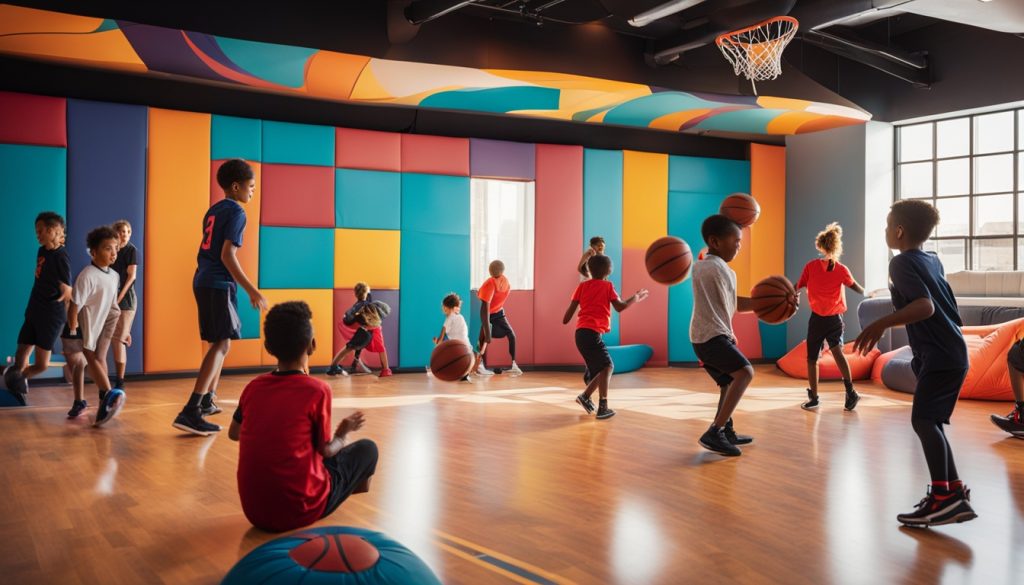
Elementary School-Aged Children
Kids grow, and so does their play. A driving course using painter’s tape is fun for ages 1-12. Sock basketball or sock hockey for ages 5-12 boosts physical skills and teamwork. Sorting games for ages 1-4 and more complex ones for kids up to 12+ keep minds sharp.
Tweens and Teens
For older kids, make a game room that matches their interests. Add comfy seating for hanging out. A chalkboard wall lets them be creative. Offer various seats to fit everyone’s style. A gaming area with games for their age is a must.
Organized spaces help kids play on their own and be creative. Show off their art to make them feel proud. Soft colors create a peaceful vibe. Tailoring your games room to each age ensures it stays fun as they grow.
Creating Zones for Different Types of Play
A multi-purpose playroom can change how your child plays. By setting up different play zones, you make a space for various interests and needs. Let’s see how to make activity centers for kids that spark their imagination and help them grow.
Begin by dividing your playroom into areas. A quiet reading nook with soft pillows is perfect for relaxing and loving books. A creative corner with art supplies and an easel is great for young artists. A building zone with blocks and construction toys helps with problem-solving skills.
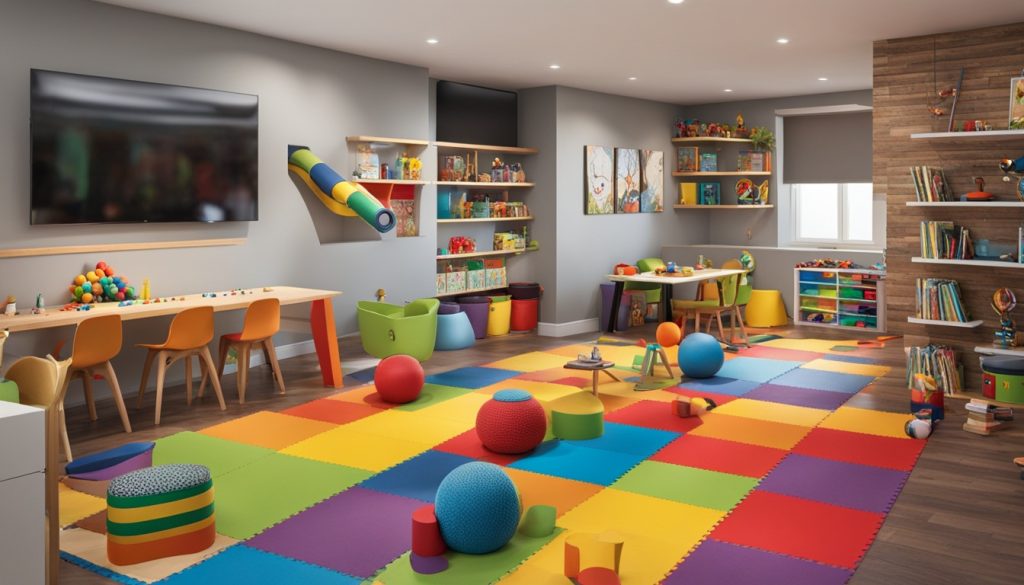
Don’t forget about active play! Set up a space for dancing or yoga. A small stage or dress-up area encourages imaginative play and boosts confidence. For older kids, a homework station with good lighting and comfy seating is useful.
Organize toys and materials in easy-to-reach storage. This teaches kids about responsibility and makes cleaning up simpler. Use labels or pictures to help younger kids know where things go.
- Reading nook
- Art corner
- Building zone
- Active play area
- Imaginative play stage
- Homework station
Your multi-purpose playroom should evolve with your child. Pick furniture and decor that can change as their interests and needs do. By making thoughtful play zones, you create a place full of learning, creativity, and fun.
Furniture Selection for Comfort and Durability
Choosing the right furniture for your child’s game room is both fun and challenging. You want it to be comfy and last a long time. Let’s look at some tips for picking furniture that’s good for kids and lasts long.
Kid-Sized Seating Options
Size is important for kid-friendly seating. Pick chairs and tables that fit your child’s height. The RAD Kidney Table costs $220 and comes with ECR4Kids Stackable Wooden Chairs ($80 for 2) for a great play area. For a cozy spot to read, consider The Nugget Play Couch at $229.
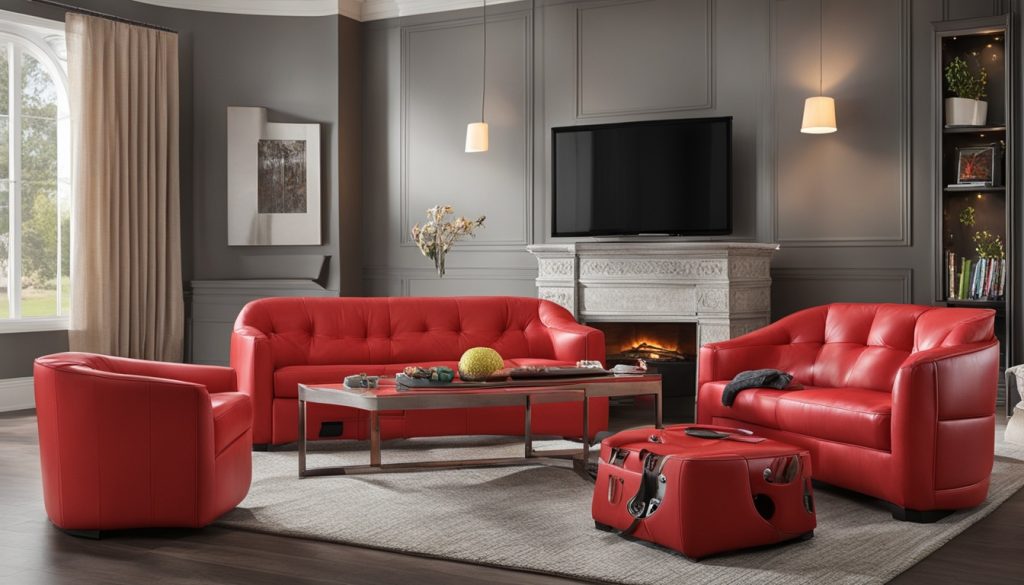
Multi-functional Furniture Pieces
Use furniture that does more than one thing. The Ikea Råskog Utility Cart ($40) can be a mobile art station or game storage. For dress-up areas, a simple clothing rack keeps costumes easy to find, as designer April Tomlin suggests.
Durable Materials for Long-lasting Use
For playroom furniture, choose durable materials that can handle lots of play. The Ikea Trofast frame ($65) with colorful storage boxes ($3 each) is a great storage option. For easy cleaning, follow designer Ariel Okin’s advice and use wipeable paints on walls and furniture.
The best furniture for a game room is fun, functional, and durable. By picking the right pieces, you’ll make a space that grows with your kids and lasts a long time.
Incorporating Technology in the Games Room
Create a kid-friendly gaming setup that blends fun and learning. Your games room can become a tech-savvy haven with the right mix of entertainment and educational technology for playrooms.
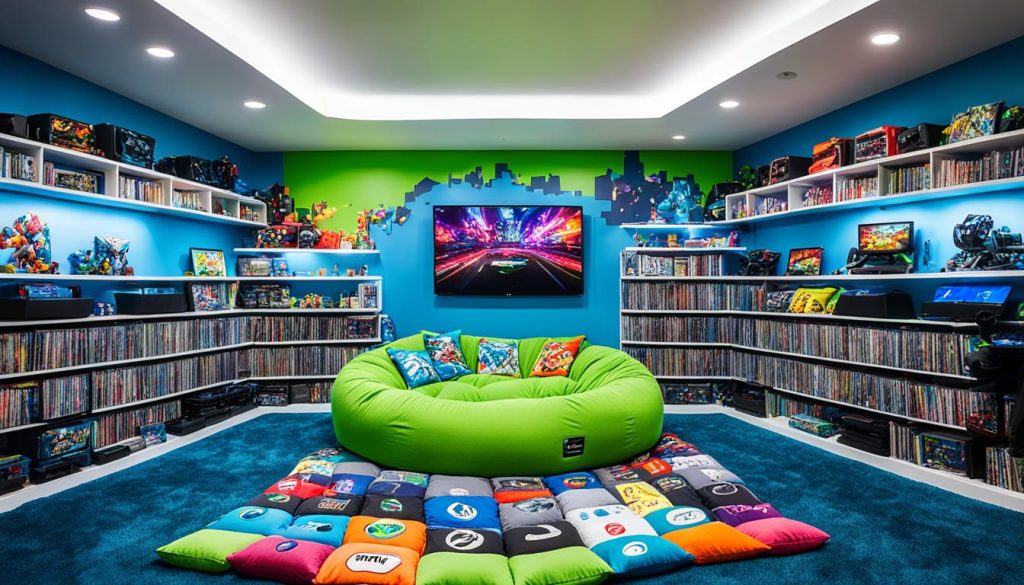
Set up a dedicated gaming area with age-appropriate consoles. Choose games that balance entertainment and skill-building. Studies show that 65% of parents prefer educational games for their children’s gaming time.
Introduce interactive play elements to boost engagement. Smart boards and tablets with learning apps make great additions. These tools can improve problem-solving skills and creativity. In fact, 78% of kids using educational technology show improved academic performance.
- Install a projector for movie nights or large-screen gaming
- Use wireless headphones for noise control
- Set up a surround sound system for immersive experiences
Remember to childproof all electronic devices and manage cables safely. This ensures a secure environment for your little ones to explore and learn through technology.
“Technology in playrooms should spark curiosity and foster learning while providing entertainment,” says leading child psychologist Dr. Emma Thompson.
By thoughtfully incorporating technology, you can create a versatile games room that grows with your kids and supports their development in the digital age.
Safety Considerations for Kids’ Play Spaces
Making a childproof playroom is key for your kids’ safety. A safe play area design helps prevent accidents and lets you relax. Let’s look at some important tips to make sure your kids can play safely.
Childproofing Essentials
First, cover electrical outlets and tie down furniture to walls. Use cord management to keep wires away from kids. Swings can be dangerous, so make sure they’re set up right if you have them indoors.
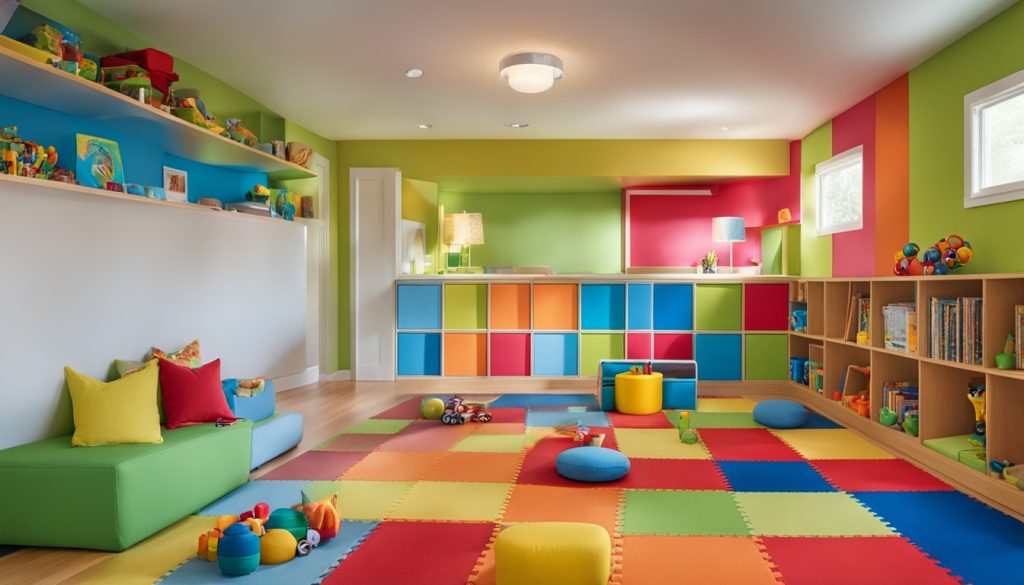
Choosing Safe Materials and Finishes
Choose paints and finishes without harmful chemicals. Pick furniture with smooth edges to avoid injuries. Soft flooring helps cushion falls. Use safety gates to keep different areas safe for various ages.
Ensuring Proper Supervision
Good lighting and clear views help you watch over your kids. Set rules like staying with parents, age limits, and no rough play. Keep dangerous items away and use locks on storage. Slides are safer when kids slide down feet-first and sitting up.
- Implement a no-shoes policy to keep the play area clean
- Exclude sick children to prevent spread of illness
- Enforce anti-bullying measures for a positive environment
- Regularly clean and sanitize all play equipment
By using these safety tips, you’ll make a safe place for your kids to play, learn, and have fun. A well-designed safe play area protects your kids and makes their playtime better.
Color Schemes and Themes for Kids’ Games Rooms
Choosing the right colors for a playroom can make it a magical place for your kids. There are many exciting options to make colorful spaces that inspire imagination and happiness. Let’s look at some great choices for themed game rooms.
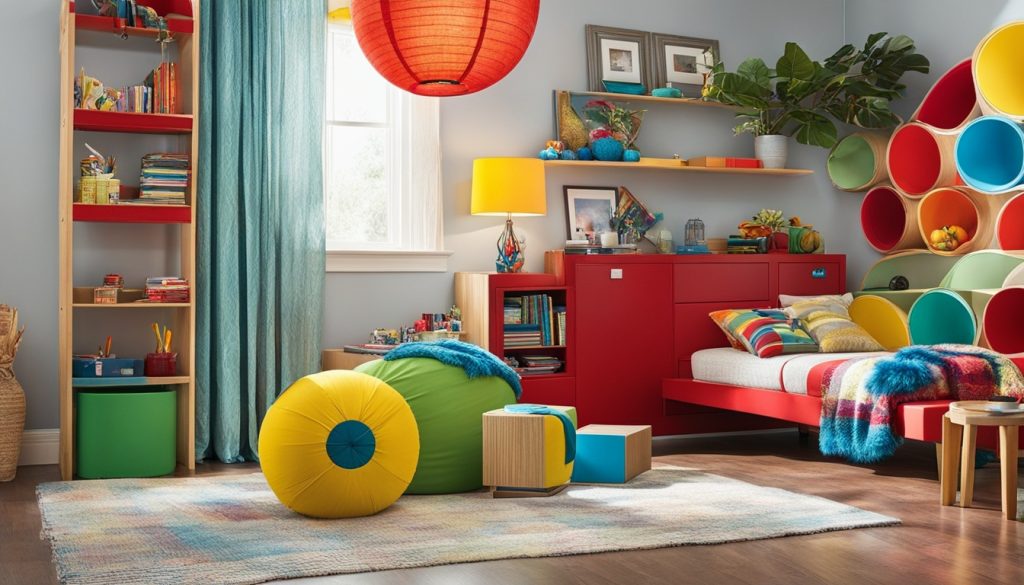
Soft pinks and lilacs make a dreamy feel, perfect for princess or fairy themes. For a lively look, try bright greens or deep teals. These colors match well with many decorations and can change as your child grows.
Blue-gray is a great choice for any child. It’s calming and works well for busy play areas. If you want more energy, bright pink or peach can make the room lively without being too much.
- Off-white walls offer a blank canvas for creativity
- Orange accents add pops of fun to small spaces
- Blue and yellow stripes create a whimsical atmosphere
Cerulean blue or eggshell are smart picks that last a long time. They make it easy to change the look as your child’s interests shift. Chalkboard paint is also a great idea – it lets kids turn walls into art spaces!
“Color is a power which directly influences the soul.” – Wassily Kandinsky
The best colors for a playroom show off your child’s personality and make the space fun and useful. With these tips, you’re ready to create themed game rooms that your kids will adore for years.
DIY Projects to Personalize the Space
Turning your kids’ play area into a special place is simple. With some DIY ideas, you can make the game room show off your child’s interests and personality.
Custom Wall Art and Murals
Make plain walls pop with colorful murals or art. A chalkboard wall is a hit with 78% of parents for endless creativity. Show off your child’s art in frames or on wire lines. For easy updates, 45% of parents use wall decals to match changing interests.
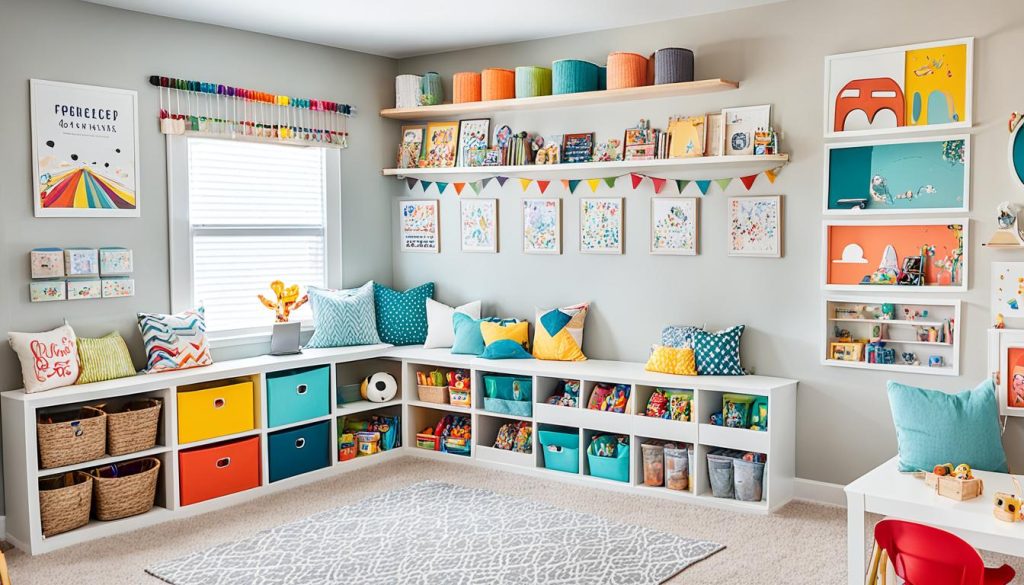
Handmade Play Elements
Make play zones that inspire imagination. A mini stage with curtains and a rod is perfect for drama. A cozy reading nook with floating shelves and pillows is great for quiet time. For active fun, add a swing or a foam block climbing wall with colorful holds.
Upcycling Furniture for the Games Room
Revamp old furniture with upcycled projects. Turn a dresser into a play kitchen or a bookshelf into a dollhouse. Storage ottomans and benches with hidden spots are a hit with 49% of parents for their dual use.
“DIY projects let you create a playroom that’s as unique as your child. It’s amazing what you can do with a little creativity and some elbow grease!”
Getting your kids involved in DIY projects is key. Let their ideas guide you, and you’ll make a space they’ll adore for years.
Lighting Options for Play and Relaxation
Creating the perfect playroom lighting is key to a fun and functional space. Smart playroom lighting ideas blend practicality with imagination. Kid-friendly light fixtures add charm while providing ample illumination for activities. For a cozy atmosphere, try mood lighting for game rooms.
Natural light is ideal during the day. Install dimmer switches to adjust brightness as needed. This allows for bright light during active play and softer lighting for winding down. Colorful table lamps or cloud-shaped pendants make great kid-friendly additions.

LED strips or string lights can highlight specific play zones. These affordable options create a magical ambiance kids love. The Govee Smart LED Strip Light offers app control and voice commands, perfect for tech-savvy families.
For a touch of whimsy, consider color-changing bulbs. At around $10 each, they’re an budget-friendly way to transform the room’s mood. Premium smart bulbs provide even more control through smartphone apps.
- The Ark Aurora Light ($29.99) projects soothing patterns
- BlissBulb Laser LightBulb ($9.99) creates starry effects
- Sky Lite ($39.99) turns ceilings into twinkling night skies
Remember to choose shatterproof and energy-efficient options like LEDs. With these playroom lighting ideas, you’ll create a space that’s both functional and fantastical for your little ones.
Flooring Choices for Active Play Areas
Choosing the right flooring for your kids’ play area is key. You want safe flooring that can handle daily use. Let’s look at some ideas that are safe, durable, and easy to keep clean.
Durable and Easy-to-Clean Options
Vinyl flooring is a top pick for active play areas. It resists spills, stains, and scratches, making it great for kids. Cleaning it is simple with just regular sweeping and occasional mopping.
Hardwood flooring is another classic choice. It’s tough and won’t slip, but it does need more cleaning than vinyl.
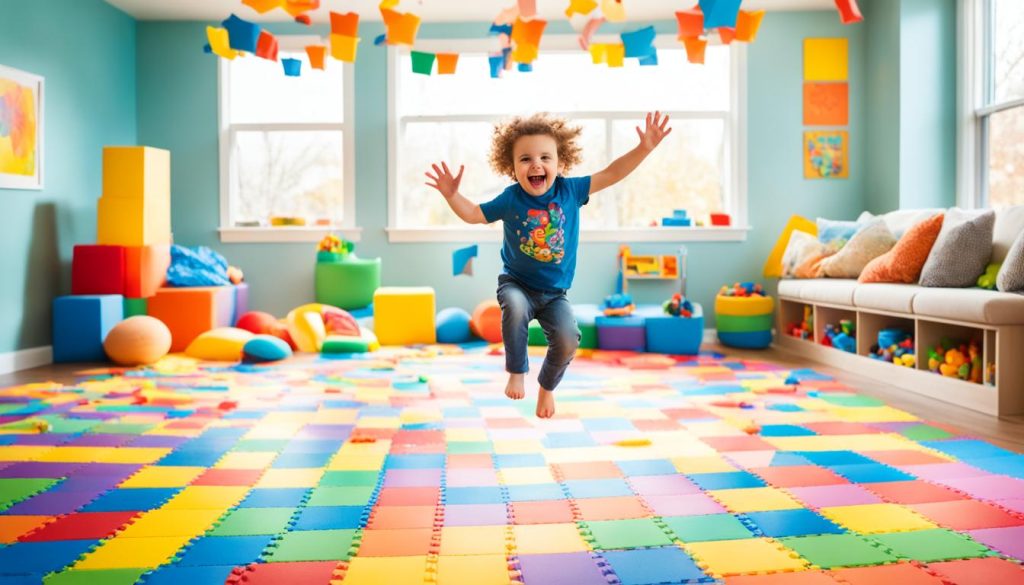
Soft Surfaces for Safety
Carpet is soft and warm for kids to play on. It mutes sounds and cushions falls, lowering the risk of slipping. Foam tiles are even safer. They absorb impacts, keep warmth in, and prevent slipping. Plus, they come in colors and patterns kids adore.
Incorporating Play Mats and Area Rugs
Play mats or area rugs add comfort and style. They’re easy to clean and can be taken out for washing. Carpet tiles are another smart choice. If a spill happens, you can just replace the tiles, not the whole floor.
The best playroom flooring is safe, durable, and easy to maintain. Think about what your family needs and your budget when picking. With the right flooring, you’ll make a space that’s fun and safe for your kids to play in for years.
Adapting the Games Room as Kids Grow
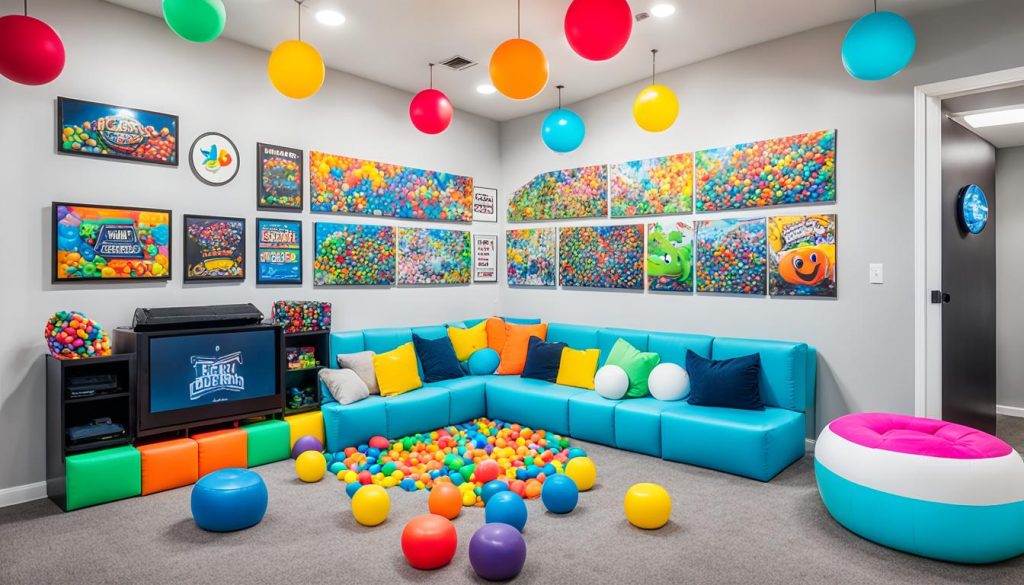
Creating spaces that change with your child is important. As kids get older, they have new interests and needs. So, it’s smart to have a playroom that can grow with them.
Buying furniture that can change is a great idea. Look for things like tables that turn into desks or storage units with different uses. For instance, a low table for toddlers can become a homework spot for older kids.
Storage is also key to keeping things tidy. Think about shelves and crates that you can move around. This way, you can fit more toys or change things up as your child grows.
- Use modular storage systems for easy reconfiguration
- Invest in flexible seating options like bean bags and floor cushions
- Incorporate easily updatable decor elements
For younger kids, themed decor can make playtime more exciting. As they get older, let them pick new themes or decor. This keeps the room fresh and helps them make choices.
Remember to plan for technology as your kids get older. They might need places to study with good lighting and spots to charge their devices. By planning ahead, you make sure the games room stays useful and fun for years.
Budget-Friendly Ideas for Creating a Fun Games Room
Creating a DIY game room on a budget doesn’t mean you have to give up fun. With creativity, you can make an exciting play space without spending a lot. Let’s look at affordable playroom ideas that will make both kids and adults happy.
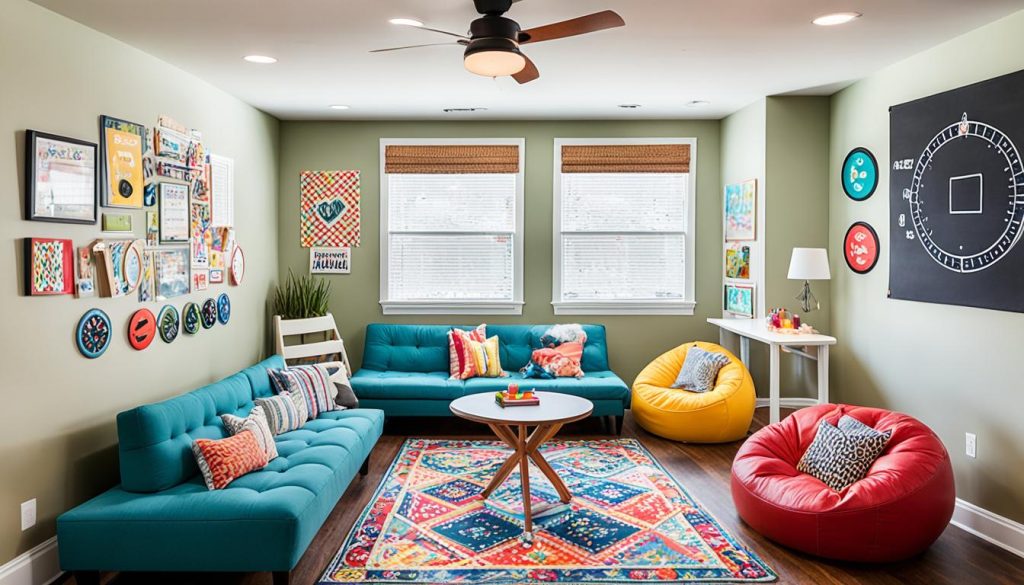
Begin by using furniture you already have. That old bookshelf is great for storing board games. And if you have a spare table, turn it into a craft station. Painting can also work wonders, refreshing old pieces and adding color to walls.
Thrift stores are full of low-cost items for your play area. Look for used toys, games, and furniture. You might find some amazing deals!
- Use plastic bins for easy toy organization
- Create a reading nook with floor pillows and a cozy rug
- Set up a art corner with a small table and supplies
Lighting is key for setting the right mood. Smart bulbs that change color are just $9.99, and portable lights can add fun for under $50. Good lighting helps with gameplay and prevents eye strain during long play sessions.
Get your kids involved in DIY projects to make the space their own. Make custom wall art or upcycle furniture together. It’s a fun way to save money and add a personal touch to your game room.
“The best game rooms reflect the personalities of those who use them. Don’t be afraid to get creative!”
With these budget-friendly ideas, you can create a gaming experience for all ages. Whether you like physical games or nostalgic arcade games, your perfect play space is within reach!
Final Thoughts
Creating fun play spaces for your kids is an exciting journey. With these games room ideas, you can turn any space into a lively place full of activity and imagination. The key to a great playroom is finding a balance between fun and practicality.
Think about what your kids like and their ages when designing the playroom. Each age group has different needs. Use furniture and storage that can change as your kids grow. Also, include things that help with learning to keep their minds sharp.
Always put safety first in your games room. Pick strong materials and furniture that won’t tip over. Make sure there’s room to move around safely. This way, your kids can play, learn, and make memories in a safe space. With careful planning and creativity, your kids’ games room will be the center of family fun for many years.



